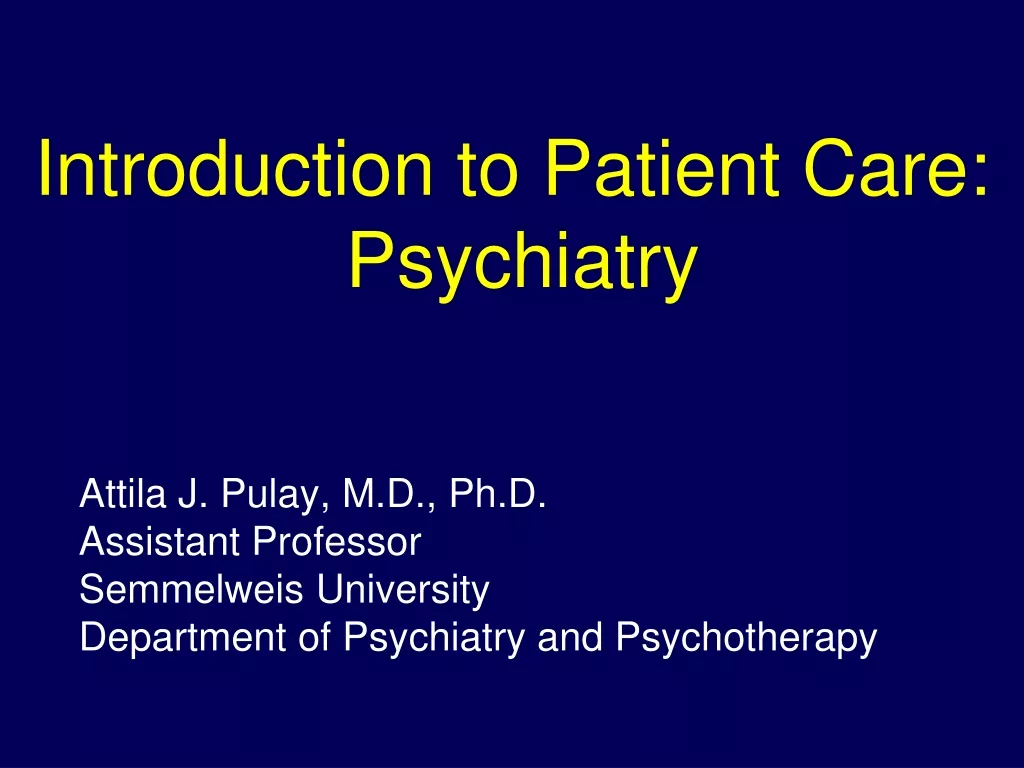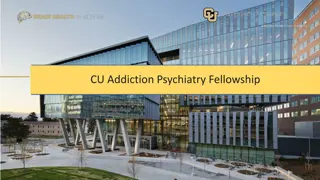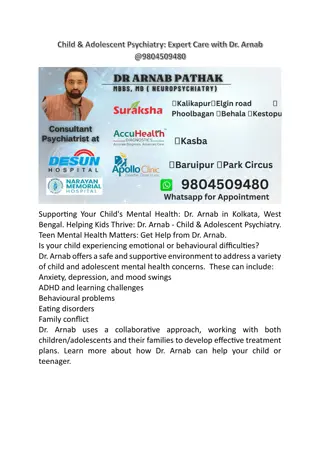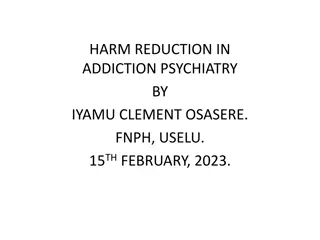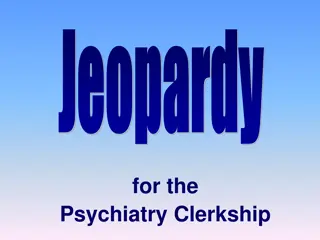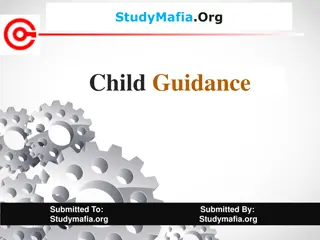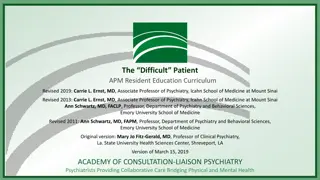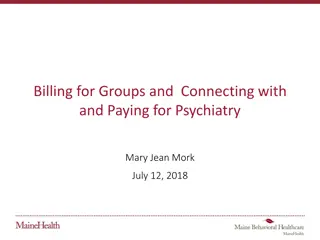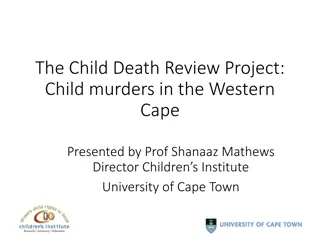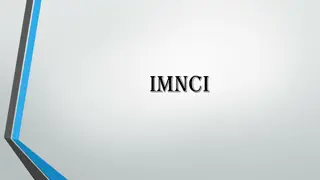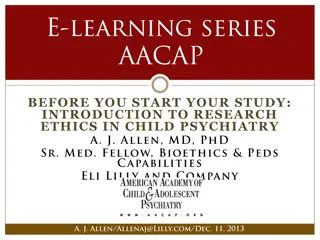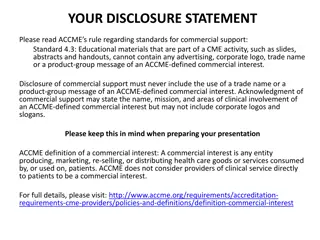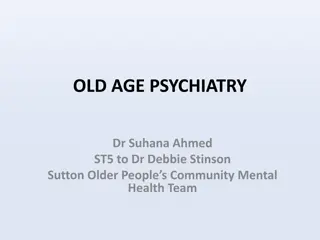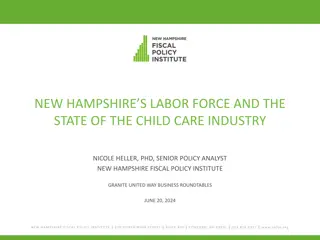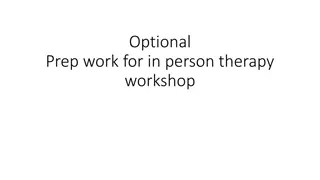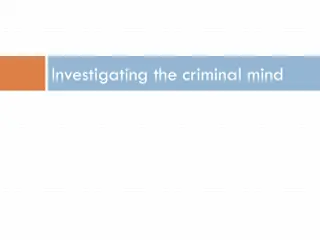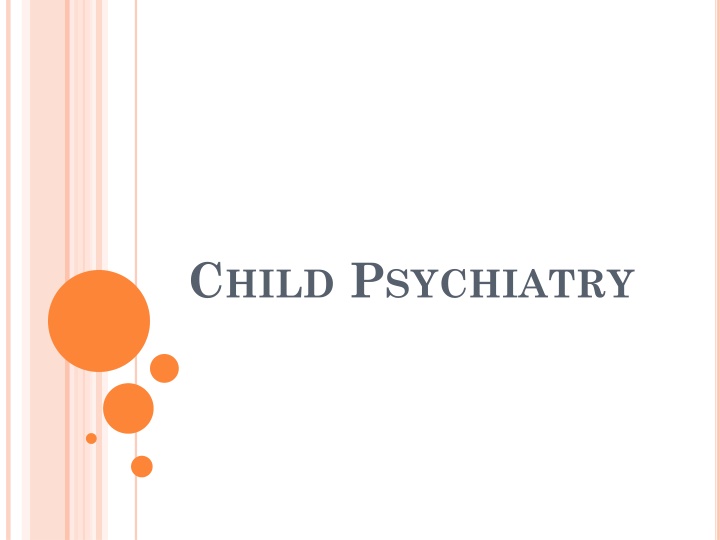
Understanding Child Psychiatry Outlines: Mental Retardation, Learning Disorder, and Behavioral Disorders
Explore key topics in child psychiatry including mental retardation, learning disorders, and disruptive behavioral disorders like Conduct Disorder and Oppositional Defiant Disorder. Learn about causes, classifications, and treatment options for these conditions.
Download Presentation

Please find below an Image/Link to download the presentation.
The content on the website is provided AS IS for your information and personal use only. It may not be sold, licensed, or shared on other websites without obtaining consent from the author. If you encounter any issues during the download, it is possible that the publisher has removed the file from their server.
You are allowed to download the files provided on this website for personal or commercial use, subject to the condition that they are used lawfully. All files are the property of their respective owners.
The content on the website is provided AS IS for your information and personal use only. It may not be sold, licensed, or shared on other websites without obtaining consent from the author.
E N D
Presentation Transcript
CHILD PSYCHIATRY (OUTLINES..) 1. Mental Retardation 2. Learning disorder 3. Disruptive behavioral disorder Conduct disorder ODD 6. Eliminiation disorder Enuresis Encopresis 4. ADHD 7. Tourett disorder & Tic disorder 5. Pervasive Developmental Disorder Autism Rett disorder Asperger Syndrome Childhood disintegrative disorder 8. Other .. Selective Mutism Separation Anxiety disorder Child Abuse
MENTAL RETARDATION IQ 70 or below adaptive skill (appropriate for age grp) Onset: before age of 18 2.5% of population 85% -- mild cases Males 2x Definition (by DSM-IV) Epidemiology Subclassification Causes Profound, Severe, Moderate, Mild --mostly no identifiable cause 1. Genetic DS, Fragile X Syndrome 2. Prenatal TORCH infection (Toxoplasmosis, Other (syphilis, AIDS, alcohol/illicit drugs), Rubella (German measles, Cytomegalovirus (CMV), Herpes simplex) 3. Perinatal (anoxia,prematurity, birth trauma) 4. Postnatal (hypothyroidisim, malnutrition, toxin exposure, trauma)
LEARNING DISORDER Definition (by DSM-IV) Achievement in reading, math & written expression that s significantly lower than expected for chronological age, level education & level intelligent Reading Math Written expression Non otherwise specified (NOS) Maybe due to gen, abnormal dev, perinatal injury, neuro /MD condition Remedial education tailored to the child s specific needs Types & Epidemiology (..disorder) 4%, Boys 3-4x ! 5%, Girls 3-10%, Unknown ratio -- Etiology Treatment
Disruptive behavioral disorder
1- CONDUCT DISORDER Dx & DSM-IV Criteria Pattern of behav. --violation of the basic rights of others or social norms & rules, with at least 3 acts within the following categories during the past year : 1. Aggression (people & animals) 2. Destruction of property 3. Deceitfulness 4. Serious violation of rules Boys : 6-16% Girls : 2-9% Up to 40% risk of dev. antisocial personality dis. in adulthood Epidemiology incidence comorbid ADHD & learning disorder incidence comorbid mood dis.,substance abuse & criminal behav. in adulthood Etiology Treatment Genetic & psychosocial factors Multimodal treatment approach Structure the child s environment with firm rules (consistently enforced) Individual psychotherapy Adjuvant pharmacotherapy (anti-psycho-lithium, SSRIs)
2- OPPOSITIONAL DEFIANT DISORDER (ODD) Dx & Definition (by DSM-IV) 1. Frequent loss of temper 2. Arguments with adults 3. Defying adult s rules 4. Deliberately annoying people 5. Easily annoyed 6. Anger & resentment 7. Spiteful 8. Blaming others At least 6m of negativistic, hostile & defiant behav., with at least 4 of : Epidemiology 16-22% children > 6 years old, usually begin at 8 Onset before puberty (boys), after puberty (equal) incidence comorbid mood dis.,substance abuse & ADHD Remits in 25% of children, may progress conduct disorder Individual psychotherapy Parental skills training Treatment
ATTENTION DEFICIT HYPERACTIVITY DISORDER (ADHD) Inattention problems listening, concentrating, paying attention to details, or organizing tasks; easily distracted, often forgetful Hyperactivity impulsivity blurting out, interrupting, fidgeting, leaving seat, talking excessively, At least 6 symptoms involving inattentiveness, hyperactivity or both that have persisted for at least 6 month Onset : before age 7 Behavior inconsistent with age & development 3-5% school-age children Boys 3-5x ! incidence comorbid mood dis, personality dis,conduct dis & ODD Mostly remit in adolescence; 20% hv symptoms into adulthood Multifactorial .. Genetic Prenatal trauma/ toxin exposure Neurochemical factors Neurophysiological factors Psychosocial factors Pharmacotherapy CNS stimulant, SSRIs/TCAs Individual psychotherapy Parental counseling Group therapy Dx & Definition (by DSM-IV) Epidemiology Etiology Treatment
Pervasive Developmental Disorder
1- AUTISM Dx & Definition (by DSM-IV) At least 6 symptoms from the following categories: 1. Problem with social interaction (at least 2) 2. Impairments in communication (at least 1) 3. Repetitive & stereotype patterns of behavior & activities (at least 1) 0.02-0.05% children under age 12 Boys 3-5x !, some familial inheritance, begin before age 3 Some associate with FXS, tuberous sclerosis, MR & seizures Apparent at early age due to delayed dev. milestones 70% of them are MR, only 1-2% can function completely independently as adults Multifactorial.. 1. Prenatal neurological insults 2. Genetics factors 3. Immunological & biochemical factors No cure ! but to help manage symptoms & improve social skills: Remedial education Behavioral therapy Neuroleptics SSRIs Stimulants (some children) Epidemiology Etiology Treatment
1. Problems with social interaction (at least two): Impairment in nonverbal behaviors (facial expression, gestures, etc.) Failure to develop peer relationships Failure to seek sharing of interests or enjoyment with others Lack of social/emotional reciprocity 2. Impairments in communication (at least one) Lack of or delayed speech Repetitive use of language Lack of varied, spontaneous play, and so on 3. Repetitive and stereotyped patterns of behavior and activities (at least one) Inflexible rituals Preoccupation with parts of objects, and so on
2- RETT DISORDER Characteristics 1. Normal prenatal & perinatal dev. 2. Normal psychomotor dev. (1st5m) 3. Normal HC (but then between 5-48 moths old) 4. Loss prev. learned purposeful hand skills (5-30m) dev. of stereotype hand movement 5. Early loss social interaction subsequent improvement 6. Severe impaired language & psychomotor dev. 7. Seizures 8. Cyanotic spells 9. Problems with gait or trunk movement Epidemiology Rare, onset : age 5-48 months old, Girls predominantly Boys : variable phenotype, dev. delay, many die in utero Genetic testing is available Etiology MECP2 gene mutation on X chromosome Treatment Supportive
3- ASPERGER SYNDROME Dx & DSM-IV Criteria 1. Impaired social interaction (at least 2) - Failure to develop peer relationships - Impaired use of nonverbal behaviors (facial expression, gestures) - Lack of seeking to share enjoyment or interests with others - Lack of social/emotional reciprocity 1. Restricted / stereotype behaviors, interest or activities (inflexible routines, repetitive movements, preoccupations, Incidence : unknown Boys > girls Unknown, may involve gen, infectious, perinatal factors Supportive Social training & behavioral modification techniques Epidemiology Etiology Treatment
4- CHILDHOOD DISINTEGRATIVE DISORDER Normal dev. in 1st2 years of life Dx & DSM-IV Criteria Loss of prev. acquired skills (at least 2) : (Language, Social skill, Bowel/ bladder control, Play, Motor skills) At least 2 of : -Impaired social interaction -Impaired use of language -Behaviors & interest (restricted, repetitive & stereotype) Rare, onset : 2-10 years old Boys 4-8x ! unknown Supportive Epidemiology Etiology Treatment
TOURETTES DISORDER & TIC DISORDER Tics Tourette s dis. : involuntary movements & vocalization : most severe tic disorder vocal tics may 1stappear may years after motor tics Motor tics Vocal tics : most common face & head (e.g eyes blinking) : Coprolalia & Echolalia Dx & DSM-IV Criteria Multiple motor & vocal tics (both must present !) Tics : occur many time a day, almost every day for >1 year (no tic-free period >3 months) Onset prior to age 18 Distress/ impairment in social/occupational functioning Epidemiology 0.05% of children Onset : 7-8 y/o, Boys 3x ! High co-morbidity with OCD & ADHD Etiology Genetics factors (50% monozygous) Neurochemical factors Treatment Pharmacotherapy (haloperidol, pimozide) Supportive psychotherapy
1-ENURESIS Urinary continence : normally establised before age 4 Enuresis : involuntary voiding of urine (bedwetting), r/o MD conditons ..1 , 2 , diurnal, nocturnal.. Involuntary voiding after age 5 Occurs at least 2x a week for 3 months or with marked impairment Epidemiology 7% of 5 years old, prevalence with age Etiology Genetic predisposition Small bladder/ low nocturnal levels of ADH Psychological stress Treatment o Behavioral modification o Pharmacotherapy antidiuretics, TCAs Dx & DSM-IV Criteria
2-ENCOPRESIS Bowel control Bowel incontinence: result in rejection by peers & impairment of social dev. Must r/o metabolism abn, lower GI prob & dietary factors. : normally achieved by age of 4 Dx & DSM-IV Criteria Involuntary/ intentional passage of feces in inappropriate places At least 4 years of age At least 1x a month for 3 month 1% of 5-year-old children Incidence with age Associated with other psychiatric condition (e.g conduct dis & ADHD) Psychosocial stressors Lack of sphincter control Constipation with overflow incontinence Therapy (psycho, family, behavioral) Stool softener (if constipate) Epidemiology Etiology Treatment
SELECTIVE MUTISM Rare condition Girls Not speaking in certain situations ( such as in school) Onset : 5-6 years old Maybe preceded by stressful life event Tx : psychotherapy (supportive, family, behavioral)
SEPARATION ANXIETY DISORDER Excessive fear of leaving one s parents or other major attachment figures May refuse to go to school (avoid it by complain of physical symptoms, refuse to sleep alone Become extremely distressed & worry excessively about losing their parents for ever 4% of school-age children Equal boys-girls Onset : around age 7, may be preceded by stressful life event Parents : afflicted by anxiety dis & may express excessive concern about their children Tx : psychotherapy ( supportive, family) & low-dose antidepressant
CHILD ABUSE Physical, emotional, sexual & neglect Doctors are legally report cases Children may be admitted to the hospital without parental consent in order to protected them Adults who were abused as children have an increased risk of developing anxiety disorders, depressive disorders,, substance abuse disorders, and posttraumatic stress disorder. They also have an increased risk of subsequently abusing their own children.
SEXUAL ABUSE: Child sexual abuse most often involves a male who knows the child. Children are most commonly sexually abused between the ages 9-12 25%of women and 12% of men report having been sexually abused as children. Evidence of sexual abuse in a child: Sexually transmitted diseases Anal or genital trauma Knowledge about specific sexual acts (inappropriate for age) Initiation of sexual activity with others Sexual play with dolls (inappropriate for age)


